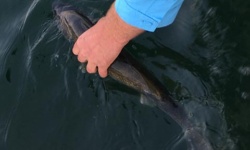Have you ever been fishing near a marsh with tall vegetation and heard some freaky sounds? Maybe you heard something that sounded like a sump-pump or growls or something akin to an owl. Chances are good you heard an elusive heron called a bittern.
We have two bittern species, the American bittern and the least bittern. Both are famously hard to spot and birders tend to hear them more than see them. They are masters of hiding in tall vegetation around marshes. If they see you before you see them, they go into their defensive posture – which is to point their beak to the sky, compress all of their feathers against their body and gently sway back and forth along with the surrounding vegetation. Their streaky plumage allows them to blend in seamlessly.
The larger American bittern has some funky folk names including “thunder pumper” and “belcher squelcher.” This relates to the male’s “song” on their territory. The birds will inhale several gulps of air, inflating their bodies like a beach ball, and then gradually let the air out to create a rhythmic sound some describe as “onk-a-chonk, onk-a-chonk, onk-a-chonk.”
Female American bitterns mate then build the nest, incubate the eggs and rear the chicks on their own. Some speculate that she builds her nest close to the male to use him as an auditory distraction against predators.
The diet of American bitterns includes fish, insects, frogs, snakes and even meadow voles. They slowly stalk their prey and are lightening fast when jabbing for something tasty.
The diminutive least bittern feeds primarily on insects but will also eat minnows, tadpoles, salamanders, mice and slugs. Unlike the über-solitary American bittern, least bitterns will rear their chicks together. The males give an easy-to-miss “po-po-po-po” type call.
American bitterns are half the size of great blue herons and least bitterns are closer in size to a green heron. Both have the ability to compress their bodies to navigate through thick vegetation in marshes. The best time to actually see the birds is in late summer when the young are leaving the nest and learning to hunt for food on their own. They will creep out to the edge of vegetation and don’t have the natural fear and caution of their parents. If you ever actually get your eyes on one, you are lucky.

![Hearing unusual wetlands sounds? Maybe it’s a hidden bittern [video]](https://jrproteam.com/wp-content/uploads/2018/07/American-Bittern-iPhone.jpg)





